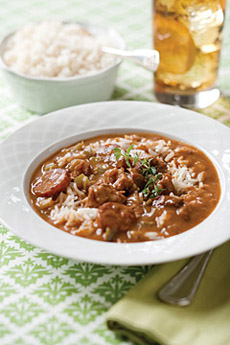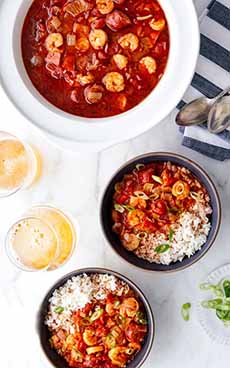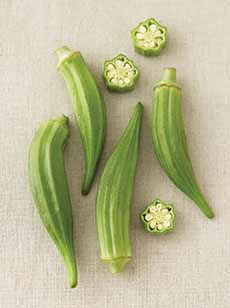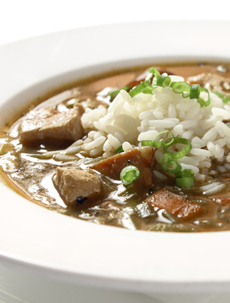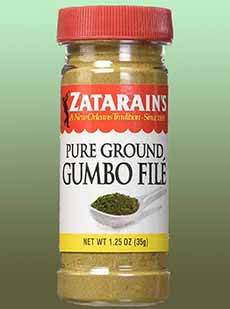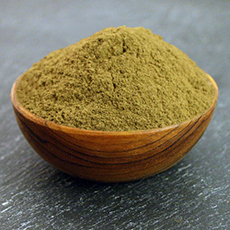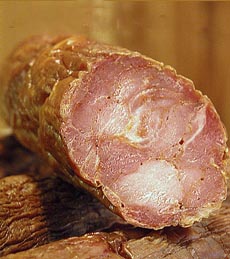Chicken Andouille Sausage Gumbo Recipe From Emeril Lagasse
|
|
With most people we know are discussing Super Bowl recipes, we’d like to throw an idea onto the table: gumbo. Even if you’ve never had gumbo, you’ve heard about it: a famous Creole* dish from Louisiana. A recipe from Emeril Lagasse is below. As with just about any dish, ingredients vary and can include just about anything: Whatever the details, the recipe will include what is called the “holy trinity” in Cajun and Creole cuisines: celery, green bell peppers, onions; plus a chicken stock base thickened with a roux (fat and flour). No gumbo would be complete without a base of white rice, over which the gumbo is ladled. And then, there’s okra (photo #3). Is gumbo a soup or a stew? It sits somewhere in between the two, and people debate this. But a key distinction is that gumbo is thicker than soup (thanks to the roux or filé powder† thickener) and features hearty chunks of meat, seafood, and vegetables. Yet, it’s more liquid than what most people think of as a typical stew. > Emeril’s gumbo recipe follows, but first: Gumbo originated in southern Louisiana during the 18th century. It’s a culinary fusion of several cultures in the area: > October 12th is National Gumbo Day. > The year’s 18 soup and stew holidays. Gumbo is an African word for okra. The vegetable came to America with the slave trade and was introduced into Southern cuisine by African cooks (photo #3). Gumbo was originally thickened with okra pods; the French added the roux for more thickening. More than a few people avoid gumbo because they don’t like the texture of okra, which is used as a thickener as well as for its flavor. Guess what: No okra is needed. Ingredients For 4 Servings 1. COMBINE the oil and flour in a large cast-iron or enameled cast-iron Dutch oven, over medium heat. Stirring slowly and constantly for 20 to 25 minutes, make a dark brown roux, the color of chocolate. 2. ADD the onions, celery, and bell peppers and continue to stir for 4-5 minutes, or until wilted. Add the sausage, salt, cayenne, and bay leaves. Continue to stir for 3 to 4 minutes. Add the water. 3. STIR until the roux mixture and water are well combined. Bring to a boil, then reduce heat to medium-low. Cook, uncovered, stirring occasionally, for 1 hour. 4. SEASON the chicken with the Essence and add it to the pot. Simmer for 2 hours, adding additional water if necessary. Gumbo should be the consistency of a somewhat thick soup. 5. SKIM off any fat that rises to the surface. Remove from the heat. Stir in the parsley, green onions, and filé powder. Remove the You can purchase Emeril’s Original Essence seasoning online. Or, you can create your own from this recipe: Ingredients Combine thoroughly: |
|
|
EMERIL’S ADVICE FOR SUPER BOWL FOOD PREP *Creole cuisine developed in Louisiana as a blend influenced by the local populations: African, French, Italian, Native American, Portuguese and Spanish, on top of the existing Southern cuisine. Creole is often confused with Cajun cuisine. Both are based on local ingredients. The key distinction is that Cajun cuisine is a rustic/peasant version of French cooking whereas Creole cuisine produces more elegant fare using classic haute cuisine techniques. **Andouille (on-DWEE) is a French word that refers to a type of coarse pork sausage made from chitterlings. The term also functions as a familiar insult for idiot or dummy. While French andouille is typically grayish-white and made with pork offal (e.g. tripe), Cajun andouille is spicy, brown, and made from pork shoulder, heavily seasoned and double-smoked. Cajun andouille is also generally more robust and flavorful due to its spices, whereas French andouille can have a more distinctive, milder, and sometimes gamey flavor from the innards. †Filé powder, made from ground sassafras leaves, is sprinkled on top of gumbo before serving. It adds additional flavor and thickening. ‡Chaurice (shore-EESE) is a spicy, coarsely, fresh (uncured) Louisiana pork sausage used extensively in Creole cooking. Chaurice is seasoned with fresh garlic and green onion. It’s related to Spanish chorizo, which is used in paella, the dish that is the forefather of Creole jambalaya. The legendary Southern chef Leah Chase swore by a good quality Chaurice in her Creole Gumbo [source], instead of smoked Andouille sausage which is preferred by others. CHECK OUT WHAT’S HAPPENING ON OUR HOME PAGE, THENIBBLE.COM. |
||
